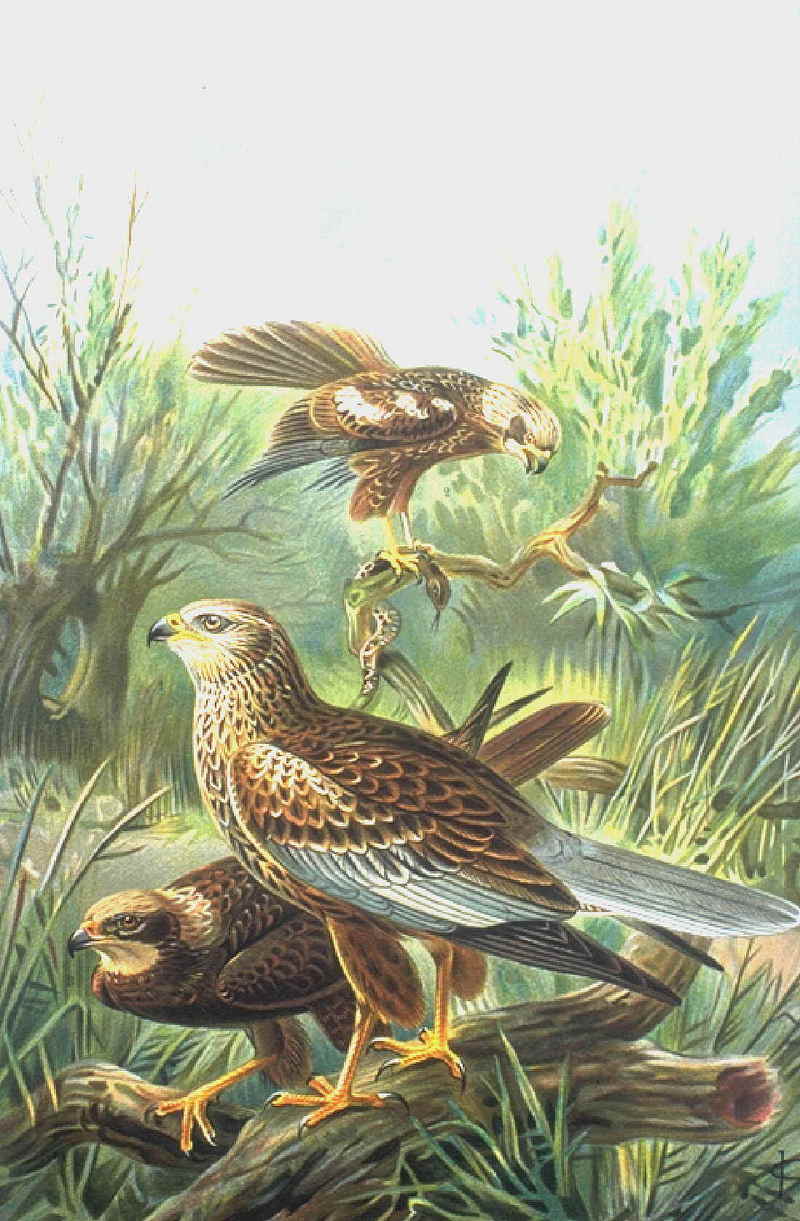|
| 질의: falconiformes | 결과: 136번째/145 | |
Western Marsh Harrier (Circus aeruginosus) - Wiki
| 제목: | Western Marsh Harrier (Circus aeruginosus) - Wiki
| |

| 해상도: 1098x1676
파일크기: 207449 Bytes
등록시간: 2007:12:07 13:32:18
|
Western Marsh Harrier
From Wikipedia, the free encyclopedia
Order: Falconiformes
Family: Accipitridae
Subfamily: Circinae
[Photo] Western Marsh Harrier (Circus aeruginosus). Male (front) and females. Source: NAUMANN, NATURGESCHICHTE DER V??GEL MITTELEUROPAS: Band V, Gera, 1899. Public Domain
The Western Marsh Harrier (Circus aeruginosus), also called Eurasian Marsh Harrier or simply Marsh Harrier, is a large bird of prey belonging to the harrier genus Circus. It has two subspecies: Circus aeruginosus aeruginosus which breeds across much of Europe and western Asia, and Circus aeruginosus harterti in north-west Africa. There are a number of other marsh harriers which were formerly classed as subspecies of Circus aeruginosus but are now usually considered to be separate species: the Eastern Marsh Harrier (Circus spilonotus) of eastern Asia, the Swamp Harrier (Circus approximans) of Australasia and the Madagascar Marsh Harrier (Circus maillardi) found on the islands of the Indian Ocean.
Description
It is 42 to 56 cm in length with a wingspan of 115 to 140 cm. It is a large, bulky harrier with fairly broad wings. The male is mostly reddish-brown with a pale yellowish head and shoulders, yellowish streaks on the breast and a grey tail. The forewing is brown and the flight feathers are grey with black wingtips. The female is dark chocolate-brown with yellowish crown, throat and shoulders although the extent of the yellowish colour is variable. Juveniles are similar to females but usually lack yellowish shoulders.
There is a rare melanistic form with largely dark plumage which mainly occurs in the east of the range.
Distribution and habitat
The species has a wide breeding range across Europe, north-west Africa, northern parts of the Middle East and Central Asia. It breeds in almost every country of Europe but is absent from northern Scandinavia and mountainous regions. It is rare in the British Isles and does not currently breed in Ireland or Wales. In the Middle East there are populations in Turkey, Iraq and Iran while in Central Asia the range extends eastwards as far as north-west China, Mongolia and the Lake Baikal region of Siberia.
The subspecies harterti breeds in Morocco, Algeria and Tunisia. These birds are sedentary but other populations of Marsh Harrier are migratory or dispersive. Some birds winter in milder regions of southern and western Europe while others migrate further to sub-Saharan Africa, Arabia, the Indian subcontinent and Myanmar.
Vagrants have reached Iceland, the Azores, Malaysia and Sumatra. The first documented (but unconfirmed) record for the Americas was one bird reportedly photographed at Chincoteague National Wildlife Refuge, Accomack County, Virginia, on December 4, 1994 (AOU 2000); subsequently, there have been confirmed records from Guadeloupe (Banks et al. 2005) and Puerto Rico (Merkord et al. 2006).
Ecology
The Marsh Harrier is strongly associated with wetland areas, especially those with reeds. It also occurs in a variety of other open habitats such as farmland and grassland, particularly where these border marshland.
It hunts by flying low over flat, open ground searching for prey with its wings held in a shallow V-shape. It feeds particularly on small mammals such as water voles and on birds but also eats insects, reptiles, amphibians, fish and carrion.
Reproduction
The start of the breeding season varies from mid-March to early May. The nest is made of sticks, reeds and grass. It is usually built in a reedbed but they will also nest in arable fields. There are usually three to eight eggs in a clutch. The eggs are oval in shape and white in colour with a bluish or greenish tinge when first laid. The eggs are incubated for 31-38 days and the young birds fledge after 35-40 days. The males often pair with two and occasionally three females. Pairs usually bond for a single breeding season but sometimes remain together for several years.
Conservation
The Marsh Harrier declined in many areas from the 19th century to the late 20th century due to persecution, habitat destruction and pesticide use. It is a now a protected species in many countries with increasing populations. In Great Britain the number of breeding females has increased from one in 1971 to over 200 today.
It still faces a number of threats including the shooting of birds migrating through the Mediterranean region. They are vulnerable to disturbance during the breeding season and also suffer from poisoning by lead shot.
http://en.wikipedia.org/wiki/Western_Marsh_Harrier
| The text in this page is based on the copyrighted Wikipedia article shown in above URL. It is used under the GNU Free Documentation License. You may redistribute it, verbatim or modified, providing that you comply with the terms of the GFDL. |
|
^o^
동물그림창고 똑똑전화 누리집
^o^
|
|